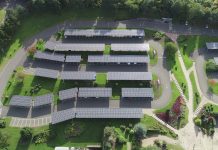The Interreg IV project SPIRE (Storage Platform for the Integration of Renewable Energy) managed by the Special European Union Projects Body provided £2.9M to address scales of energy storage required in the Ireland/Northern Ireland Cross Border Region. The project led by Ulster University’s Centre for Sustainable Technologies brought together the Centre for Renewable Energy at Dundalk IT (CREDIT) and through an Official Journal of the European Community tender process, Gaelectric Energy Storage Ltd.
The aim of the project was to assess the likely volumes of energy storage required by the all-Ireland Single Electricity Market (SEM) given its likely high penetration rate (>40% by 2020) of non-dispatchable, variable wind energy. A series of scenarios examined the impacts of wind energy on the SEM developed in 2050 and incorporated alternative technologies such as advanced gas turbines and CCGTs and interconnection to other markets.
The scenarios are supported by a series of research initiatives examining different scales of energy storage, namely a) Large utility-scale (represented by Compressed Air Energy Storage – CAES); b) Industrial site scale (through flow batteries and ice banks) and c) Domestic scale (through heat pumps and energy thermal storage).
CAES would be incorporated into local salt deposits at Larne, Northern Ireland, UK and proposed compressions of air to >100bar during periods of excess wind capacity. Solution mining of a cavern at depths of about 1700m would provide 200-300MW of storage capacity and the air would be used to offset combined cycle gas turbine air compressors, thus increasing local power station efficiency.
A program of test drilling was initiated and results indicated that salt deposits at shallower depths (~900m) had greater geological complexity than first anticipated. The salts at greater depths were more suitable. CAES systems appear to be more cost-effective than other large scale storage systems.
Intermediate scale energy storage supports wind turbines operating on large sites. Dundalk Institute of Technology used its 850kW wind turbine coupled with an ice-bank for cooling computer laboratories and 500kWh flow battery to evaluate system performance. The complexities of urban installations of wind turbines were evaluated through the novel deployment of lidar technologies to examine the variable air flows around buildings. Results indicated that electricity and heat combinations worked well for building applications.
Ulster University developed a heat pump and thermal storage facility on its “Terrace Street” test houses. These are fully instrumented Victorian terraced houses lived in by families that are now converted successfully from gas boilers to high-temperature heat pumps and 600 litres of water-based thermal storage. Initial results are promising with thermal comfort being maintained, running costs reduced and pricing signals from the electricity system operator integrated to optimally utilise the storage when electricity demands are high and charge when electricity demands are low.
Finally, these three sets of performance characteristics were integrated into the SEM electricity market model developed in PLEXOS which indicated through a series of scenarios, the likely scales, costs and benefits on the SEM of different combinations of storage up to 2050. Demand-side management with heat pumps and energy storage coupled with CAES looked promising but the overall conclusion was that there is capacity for many different approaches provided that they were assisted in their deployment through payments under ancillary services.
The author would like to thank staff, partners, Steering Committee Members (DCENR, Invest NI, Eirgrid) and the Special European Union Projects Body for their support through this challenging but fulfilling project.
Professor NJ Hewitt BSc DPhil
CEng CPhys MInstP MInstR MEI
Director
Centre for Sustainable Technologies Ulster University
Tel: +44 (0) 28 903 68566
Fax: +44 (0) 28 903 68239
nj.hewitt@ulster.ac.uk










